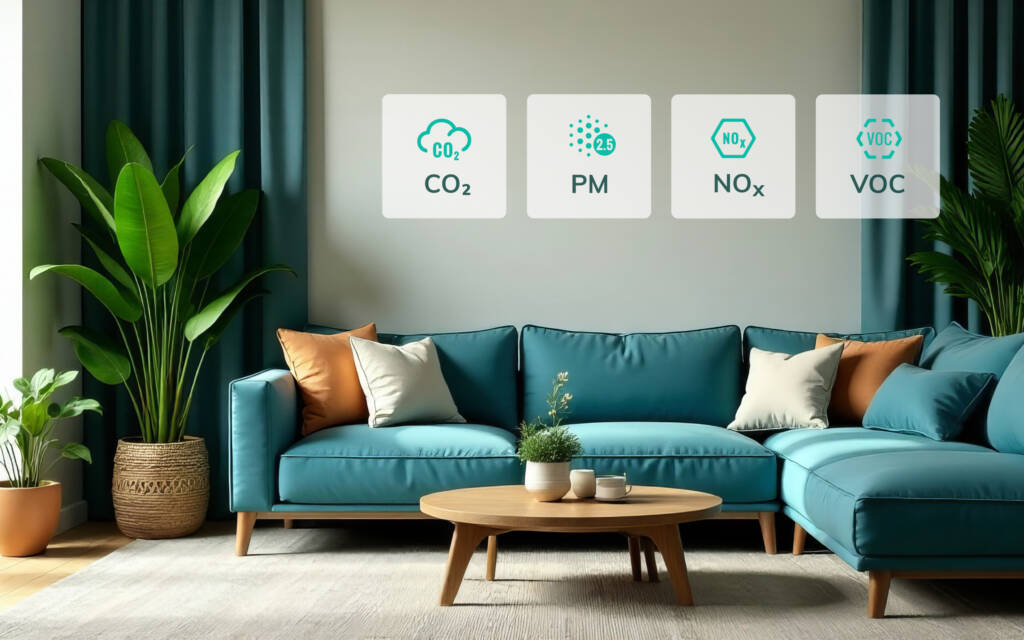
Indoor air quality is one of the most important, and often overlooked, factors influencing our health, comfort, and productivity. As urban living and energy-efficient building practices become the norm, the air inside our homes and offices can sometimes be more polluted than the air outside. Understanding and monitoring indoor air quality is a key step toward creating healthier, more comfortable spaces for living, working, and relaxing.
Why Indoor Air Quality Matters
Most people spend about 90% of their time indoors, whether at home, in the office, or at school. Indoor air can be two to five times more polluted than outdoor air, with contaminants coming from sources such as building materials, cleaning products, cooking, and even the people in the space. Poor indoor air quality (IAQ) is linked to a range of health concerns:
- Respiratory issues, allergies, and asthma
- Headaches, fatigue, and difficulty concentrating
- Long-term risks such as cardiovascular disease and cancer
Certain groups; including children, the elderly, and those with pre-existing health conditions are especially sensitive to common indoor air pollutants.

Common Indoor Air Pollutants That Influence Well-Being
Indoor air might seem clean at a glance, but it often contains a mixture of invisible pollutants that can accumulate over time. Everyday actions such as cooking, cleaning, or even just spending time indoors can introduce various contaminants into the air. The materials used in your home’s construction, furniture, and everyday products also contribute to the mix.
If ventilation is limited, these substances tend to build up, sometimes reaching levels much higher than what is found outside. Becoming aware of the most common indoor pollutants and understanding their potential health impacts helps you take the first step toward a healthier home environment.
- Carbon Dioxide (CO₂): CO₂ is a natural byproduct of breathing, but it can build up quickly in poorly ventilated spaces. Elevated CO₂ levels are a strong indicator of insufficient ventilation and can directly impact how you feel and perform especially in offices and classrooms.
- Particulate Matter (PM): Tiny particles from dust, smoke, or cooking can become trapped indoors, aggravating respiratory conditions and reducing overall air quality.
- Nitrogen Oxides (NOx): Nitrogen oxides from car exhaust, candles, and cooking can irritate the respiratory system, degrade indoor air quality, and long-term exposure can increase the risk of respiratory illnesses.
- Volatile Organic Compounds (VOCs): VOCs are chemicals released from many household products, paints, and furnishings. They can irritate the eyes, nose, and throat, and long-term exposure may increase the risk of chronic diseases.
- Temperature and Humidity: Comfortable temperatures and balanced humidity are essential for well-being. Too much humidity encourages mold growth, while dry air can irritate the skin and airways. In the bedroom, for example, a temperature around 20°C and relative humidity between 30% and 50% supports restful sleep and better health.

CO₂: The Hidden Impact on Productivity and Cognitive Performance
Carbon dioxide (CO₂) is invisible and odorless, but its effects are very real. In homes and offices where windows are rarely opened or ventilation is poor, CO₂ levels can rise above recommended limits, and sometimes without anyone noticing.
Scientific studies have shown that:
- Even moderate increases in CO₂ (from 945ppm upwards) can significantly decrease cognitive performance, productivity, and decision-making, long before reaching occupational exposure limits.
- At higher indoor concentrations (2,000–5,000ppm), people report headaches, fatigue, and general discomfort.
- Decision-making, information processing, and creative problem-solving all suffer as CO₂ increases.
In offices, this means that poor air quality can quietly reduce productivity, increase mistakes, and even impact job satisfaction. In homes, high CO₂ can lead to restless sleep and daytime fatigue.
Why Monitoring Matters
The first step to improving indoor air quality is awareness. Many pollutants like CO₂, VOCs, and fine particles are invisible to our senses, but their effects accumulate over time. Monitoring these factors helps you:
- Identify sources of poor air quality
- Take action with ventilation or air purification
- Maintain optimal temperature and humidity for comfort and health
Simple Solutions for Healthier Spaces
Modern technology makes it easy to monitor indoor air quality. Wireless sensors, like RuuviTag provide real-time data on temperature, humidity, and air pressure. With these tools, you can:
- Set up alerts for changing conditions
- Track trends and make informed decisions
- Optimize your home or office environment for both comfort and productivity
For remote monitoring or larger spaces, Ruuvi Gateway enables data collection and alerts from anywhere, supporting proactive management of your indoor environment.
Ruuvi Air: Comprehensive Indoor Air Quality Made Simple
The newly released Ruuvi Air sensor represents the next generation of comprehensive indoor air quality monitoring, designed to measure CO2, particulate matter, VOCs, nitric oxides, temperature, humidity, and air pressure in a single device. This multi-parameter approach provides homeowners with unprecedented insights into their indoor environment, enabling proactive management of air quality conditions.
As indoor air quality monitoring becomes increasingly recognized as essential for health and productivity, Ruuvi Air addresses the growing demand for accessible, comprehensive monitoring solutions. The device’s multi-parameter sensor integration reflects current industry trends toward holistic air quality assessment, providing the data needed to optimize indoor environments for health, comfort, and performance while supporting the transition to smarter, more responsive indoor spaces.
Conclusion: Key takeaways regarding indoor air quality
Good indoor air quality is essential for well-being, whether at home or at work. By understanding and monitoring key factors like CO₂, VOCs, particulate matter, temperature, and humidity, you can create spaces that support better health, sharper thinking, and improved productivity. Tools like RuuviTag make it easy to stay informed and take control of your environment: one breath at a time.
FAQ: How Air Quality Affects Your Well-Being at Home and Work
What is indoor air quality and why is it important?
Indoor air quality (IAQ) refers to the air within and around buildings, especially as it affects health and comfort. Good IAQ is essential for respiratory health, sleep quality, and overall well-being. Poor air can cause allergies, asthma, headaches, and other health issues.
What are the most common indoor air pollutants?
Common pollutants include dust, pet dander, mold spores, volatile organic compounds (VOCs) from cleaning products and furniture, particulate matter (PM2.5), and carbon dioxide (CO₂). Excess humidity can also promote mold growth and worsen air quality.
How can I monitor air quality at home or work?
You can monitor air quality using smart sensors which measure CO₂, VOCs, particulate matter, temperature, humidity, light, and sound in real time. RuuviTag sensors are also ideal for tracking temperature and humidity.
What are the optimal temperature and humidity levels for a healthy indoor environment?
For a healthy and comfortable indoor environment, most scientific and health authorities recommend maintaining room temperatures between 20°C and 24°C (68–75°F) and relative humidity between 30% and 50%.
How can I reduce indoor air pollutants?
Improve ventilation by opening windows or using fans, control sources by choosing low-VOC products, manage humidity, and clean regularly with HEPA-filter vacuums. Smart sensors help you identify and respond to air quality issues promptly.
Can smart sensors help with air quality management?
Yes, smart sensors can provide real-time data and alerts, making it easy to maintain healthy air quality.
How do I set up and use a Ruuvi sensor?
Simply place the sensor in the desired location and connect it to the Ruuvi Station app on your smartphone. You can view real-time data, set alerts, and track trends to keep your home or office environment healthy.